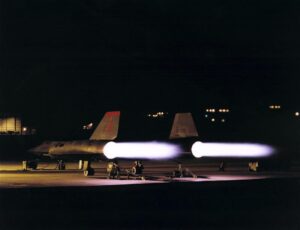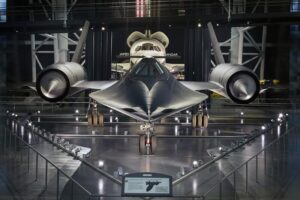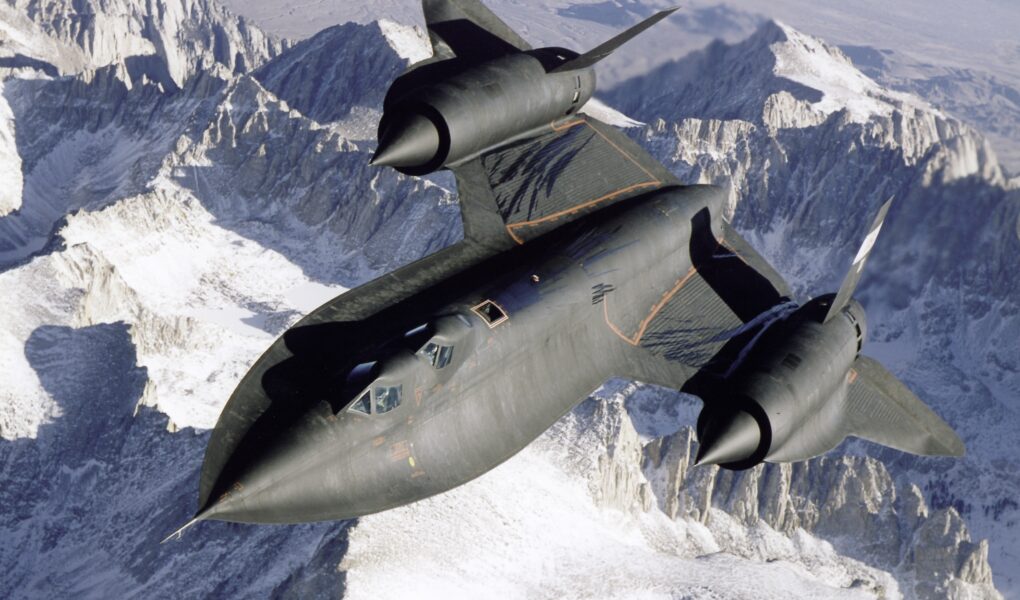Abstract
The SR-71 “Blackbird” was a Strategic Reconnaissance aircraft designed in the late 1950’s and built in the early 1960’s [2]. It was born out of a necessity for high performance and stealth as Soviet Union missile technology began to threaten the safety of United States Air Force pilots working in intelligence acquisition [2]. Engineers at Lockheed Martin quickly filled these design requirements with the radar-deceiving SR-71. The Blackbird was primarily used to gather intelligence on contentious geopolitical locations and events that could not be observed with satellites [1]. It could travel at speeds faster than any surface-to-air missile and broke its own airspeed world records numerous times [1, 2, 10]. The performance output of this aircraft immediately made it the go-to option for any and every reconnaissance mission throughout the Cold War [1]. However, its unparalleled speed created major issues surrounding engine modification, heat generation concerns, navigational problems, and stealth considerations.
Keywords: SR-71, Blackbird, Stealth, Ramjet, Supersonic aircraft
It was the end of the 1960’s and the Cold War was heating up. A Soviet Union radar specialist was at his post, diligently watching the screen. Suddenly, the radar picked up an object too small to be an aircraft but moving too fast to be a bird. Confused, the specialist notified his commanding officer of the situation, and the officer turned red with anger and frustration. He immediately ordered the object to be targeted by a surface-to-air missile.
United States Air Force pilot Colonel Jim Wadkins was concentrated on the mission. He was holding a steady altitude of 80,000 feet when he saw the red flash of the “Incoming Missile” warning indicator. Colonel Wadkins simply accelerated from Mach 2 to Mach 3, and the indicator turned off.
The radar specialist, watching the situation unfold from the screen, was baffled at the sight of the missile missing its target. He looked at the officer and asked, “What was that?”
The Lockheed Martin SR-71 was the crown jewel of a class of long-range Strategic Reconnaissance aircraft used to gather intelligence on Soviet military deployments and other geopolitical interests [1]. It was first conceived in the late 1950’s when concerns grew about the older U-2 reconnaissance aircraft being particularly susceptible to ground missile strikes [1]. On May 1, 1960, this nightmare unfolded.
Origins of the SR -71
Pilot Gary Powers was flying a mission over the Soviet Union when his U-2 was hit by an advanced Soviet surface-to-air missile. Luckily, Powers was able to eject before the aircraft crashed. When President Eisenhower was informed of this event, he put out the call for a newly designed strategic reconnaissance aircraft that could not be shot down and to have it done yesterday [2]. Lockheed Martin’s Advanced Development Team, Skunk Works, had already been working on a viable replacement.
Their answer to the call was the SR-71, a supersonic aircraft that could travel at more than 2,000 miles per hour at an altitude of 80,000 feet and be almost completely undetectable by radar [2]. For comparison, the average modern day commercial turbojet flies at speeds close to 500 miles per hour at around 24,000 feet. This means that the cruising speed of the SR-71 was 4 times greater and its cruising altitude was more than 3 times higher than a typical airplane.

Figure 1. The SR-71. Credit: [6]
The final iteration of the SR-71 made its first flight on December 22, 1964, and was then released to the US Air Force to take over strategic reconnaissance in the Spring of 1968 [2,1]. Building a long-range aircraft was difficult enough, and adding the extra challenge of supersonic speed was next to impossible. Not only was it difficult to squeeze that amount of power into a jet engine, but other challenges arose such as temperature rise, navigational precision, and camouflaged radar. Skunk Works engineers needed to find unique solutions to these problems to ensure that the SR-71 was a fully functioning, supersonic, stealth strategic reconnaissance aircraft that could stay on target and evade any missile attack.
The Pratt & Whitney J58 Jet Engine
The SR-71 used a modified J58 engine–the popular choice for the Navy and Air Force [3]. Modifications were necessary because at speeds approaching the design requirement of 2,000 miles per hour, the incoming air supply to the engine would be too hot and moving too quickly to be used effectively [4].
A typical airplane turbojet engine draws in air through a fan, compresses and mixes the air with fuel, ignites the mixture, and sends the mixture through a turbine and out through a nozzle at the back of the engine. This mechanism powers the aircraft’s electrical systems and produces thrust for stable flight. The speed of the incoming air is important for both engine stability and engine performance. When air moves at supersonic speeds, as it did for the SR-71, it behaves unlike the air flow for a traditional jet engine. The flow becomes compressible, superheated, and generally unusable. The SR-71 needed to use a jet engine that could reduce the speed and temperature of the incoming air to a workable limit [3]. Thus, Skunk Works engineers modified the J58 engine to do just that.

Figure 2. J58 static fire. Credit: [3]
They first added a series of bleed valves at various stages of the engine and a conical spike at the front of the engine
The bleed valves reduced air volume and air intake speed at key locations throughout the engine to increase performance and stability [3]. A portion of the bleed air was dumped into the afterburner of the engine–an additional component on certain aircraft that combusts any exhaust gas that was not burned in the original reaction. Unlike almost every other aircraft that utilizes an afterburner, the SR-71 ran its afterburner continuously to maximize speed, which came at the cost of enormous heat generation [3]. To address this issue, the remaining bleed air was routed around the engine casing to cool down the combustor, nozzle assembly, and afterburner [3,4].

Figure 3. The J58 SR-71 engine test. Credit: [3]
The “aerospike” cone on the intake could extend or retract to optimize the location of shocks–jumps in air temperature, density, and pressure [4]. When supersonic air comes in contact with a barrier, such as the inlet of an engine, it suddenly drops in pressure, temperature, and density. This phenomenon is known as an aerodynamic shock and is generally characterized as a discontinuous decrease in airstream velocity.The Skunk Works engineers decided to use this shock phenomenon to their advantage. By controlling where the shock occurred on the intake, they could control the velocity jump across the shock and thus, decrease the speed of the incoming air [4]. The optimal location of the shock would need to change depending on the flight profile, so the entire aerospike cone was designed to translate forward and backward up to 26 inches to accommodate the ideal shock placement [4]. With this modification, the engineers boosted the performance of the J58 engines and increased the speed of the SR-71 to more than three times the speed of sound.
Heat Considerations
Not only could the SR-71 reach supersonic speeds, but it could sustain these speeds for hours on end [2]. This was a revolutionary feat of engineering as no other aircraft at the time could achieve a similar speed for as long of a time [2]. However, this accomplishment caused serious issues in the rest of the aircraft design. One of the largest side effects of this unbelievable airspeed was heat generation across the aircraft.
Along with the cooling brought by the bleed air, the SR-71 engineers utilized the fuel itself as a coolant [3]. However, since the engines could reach temperatures upwards of 1,000 degrees Fahrenheit [5], they needed to use a less combustible fuel to ensure that the engine would not explode when it came in contact with such high temperatures [3]. By adding a very small amount of extremely unstable fuel to the extremely stable main fuel, the engineers were able to jumpstart the reaction of the main fuel and keep the engines from experiencing a runaway heating situation by running the fuel through heat exchangers around the engines.
At its cruising speed, it was not uncommon for the fuselage to reach temperatures of over 600 degrees Fahrenheit [5]. One of the pilots of the SR-71 noted that the cockpit glass was made from oven glass because it was normal for the windows to exceed 620 degrees Fahrenheit [6]. Skin heating issues were addressed by completely changing the materials of the aircraft. Instead of a conventional aluminum or stainless steel, engineers used titanium alloys due to their high strength to weight ratio and resistance to heating effects [5].
The engineers also accounted for heat swelling–the expansion of a material under extreme temperatures. The heat of the aircraft caused the skin panels to expand over four inches from nose to tail [6]. This lengthening was accommodated by under-sizing the panels so that the panels would expand to their correct size when the SR-71 reached its cruising speed [1]. When it was not flying at supersonic speeds, such as when it was parked on the runway or slowed down for refueling, the SR-71 would leak fuel because its skin panels did not fit correctly [1]. However, this modification was included in the final design because it helped to cool the skin of the plane greatly.
Another cooling method that engineers employed to decrease the skin temperature of the SR-71 was to paint it black [2]. The hotter an object is, the more heat it will radiate. This process can be optimized by making an object a blackbody. In physics, a blackbody is a perfect receiver and emitter of radiation which can be in the form of heat. By physically painting the SR-71 black, engineers made the aircraft a perfect emitter of heat which worked to cool it even further [2]. This painting technique is how the SR-71 received its unofficial nickname, “The Blackbird” [2].
Navigation
At supersonic speeds, navigation becomes a major issue as on-the-fly decisions can have drastic impacts on heading and position. Normal pilots are able to navigate terrain via landmarks such as buildings, cities, rivers, and highways, but the SR-71 moved too quickly for any of these references to be useful. Pilots would have to navigate in relation to oceans, coasts, mountain ranges, and other large geographic features [2]. Since this method of navigation was not a viable solution to a well guided course, especially when flying at 80,000 feet, engineers developed a navigation system that utilized a star tracker and gyroscope to reduce the error in the Blackbird’s flight plan [7].
The Astroinertial Navigation System (ANS) tracked two or more stars by day or night and recorded the exact time of these measurements [8]. It then calculated the position of the aircraft to within 300 feet of the flight path with respect to the surface of the earth [8]. With this geographic positioning, the ANS would relay the aircraft’s heading and altitude to the pilot and provide an accurate location to associate with any reconnaissance imaging operations [7]. Pilots could now navigate effectively using their cockpit instruments. However, since the SR-71 Blackbird would cruise at Mach 3.2, an imprecise heading by a few degrees could shift the aircraft hundreds of miles away from its flight path.

Figure 4. The ANS was located just behind the cockpit, facing upward. Credit: [8]
Once again, Skunk Works engineers set about solving this problem. They installed an autopilot computer system that would receive the position data from the ANS and use it to steer the aircraft along a pre planned flight path [7]. At the time of its operation in the 1960’s, flight plans were uploaded to the computer memory before the flight using a punched mission tape [7, 8]. After the mission tape was loaded onto the computer memory, the SR-71 could perform the entire flight on autopilot and record reconnaissance data [7]. The crew was responsible for monitoring the flight and taking control when manual operation was required, such as during takeoff and landing or in the case of an incoming missile attack.
Stealth Technology
Lastly, the SR-71 had to be a stealth aircraft, camouflaged to radar signals. Along with special radar jamming equipment, the Blackbird’s black paint used a special radar absorbing element to reduce the amount of reflected waves off the body of the aircraft [1]. Engineers also augmented the geometry of surfaces of the fuselage to either absorb radar signals or reflect them in erroneous directions [2]. They moved the location of the engines closer to the body of the aircraft to reduce their radar footprint [2]. These designs allowed the SR-71 to show up on a radar screen larger than a bird but smaller than a person [2].
Conclusion
The SR-71 Blackbird began as a concept and dream by the engineers of Lockheed Martin’s Advanced Development Team, Skunk Works. It soon transformed from a dream to a necessity as the Cold War heated up and the Strategic Reconnaissance division was starting to take losses. Through the marvel of engineering, the SR-71 turned into an unstoppable machine with over 4,000 missiles launched at it and not a single hit [10].
The awe of this masterpiece goes on and on, but it can be summed up in its last flight, where the SR-71 set the world record for the fastest jet-propelled, manned aircraft, averaging 2,124 miles per hour traveling from Los Angeles, California, to Washington DC in 1 hour, 4 minutes, and 20 seconds [1].

Figure 6. The final resting place of one of the last remain SR-71 Blackbirds is in the Smithsonian National Air and Space Museum. Credit: [1]
References
[1] “Lockheed SR-71 Blackbird,” Smithsonian Institution. [Online]. Available: https://www.si.edu/object/lockheed-sr-71-blackbird%3Anasm_A19920072000. [Accessed: 02-Apr-2022].
[2] “Creating the Blackbird,” Lockheed Martin, 10-Jan-2021. [Online]. Available: https://www.lockheedmartin.com/en-us/news/features/history/blackbird.html. [Accessed: 02-Apr-2022].
[3] “J58 the powerplant for the blackbirds,” The SR-71 Blackbird, 31-Jan-2022. [Online]. Available: https://www.thesr71blackbird.com/Aircraft/Engines/j58-the powerplant-for-the-blackbirds. [Accessed: 02-Apr-2022].
[4] J. T. Anderson, “How Supersonic Inlets Work: Details of the SR-71 Mixed Compression Inlet Geometry and Operation,” SR-71 inlets, 01-May-2014. [Online]. Available: http://www.enginehistory.org/Convention/2014/SR-71Inlts/SR-71Inlts.shtml. [Accessed: 02-Apr-2022].
[5] M. Lladó Bordas, “Study of the Lockheed SR-71 structure and reproduction of a 1:20 scale model,” Pàgina inicial de UPCommons, 30-Jun-2020. [Online]. Available: https://upcommons.upc.edu/handle/2117/331262. [Accessed: 02-Apr-2022].
[6] K. Mizokami, “A veteran pilot explains what it was like to fly the SR-71 Blackbird,” Popular Mechanics, 29-Apr-2021. [Online]. Available: https://www.popularmechanics.com/military/aviation/a27962424/sr-71 blackbird/. [Accessed: 02-Apr-2022].
[7] P. R. K. IV, “71 Flight Manual,” SR, 2010. [Online]. Available: https://www.sr-71.org/blackbird/manual/4/4-18.php. [Accessed: 02-Apr-2022].
[8] D. Leone, “The SR-71 Astroinertial Navigation System, aka R2-D2, was crucial in Blackbird Mission. here’s why.,” The Aviation Geek Club, 08-Aug-2021. [Online]. Available: https://theaviationgeekclub.com/the-sr-71-astroinertial-navigation-system-aka-r2-d2-was-crucial-in-blackbird-mission-heres-why/#:~:text=The%20SR%2D71%20needed%20to,ten%20hours%20in%20the%20air. [Accessed: 02-Apr-2022].
[9] B. Dunbar, “NASA Armstrong Fact Sheets – SR-71 Blackbird,” NASA, 07-Aug-2017. [Online]. Available: https://www.nasa.gov/centers/armstrong/news/FactSheets/FS-030-DFRC.html. [Accessed: 03-Apr-2022].
[10] S. Silver, “An insane 4,000 missiles were fired at the SR-71 spy plane. they all missed,” 19FortyFive, 26-Oct-2021. [Online]. Available: https://www.19fortyfive.com/2021/10/an-insane-4000-missiles-were-fired-at-the-sr-71 spy-plane-they-all-missed/. [Accessed: 03-Apr-2022].



